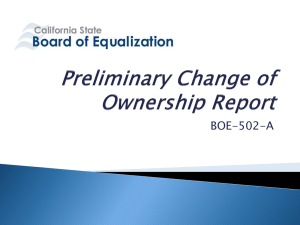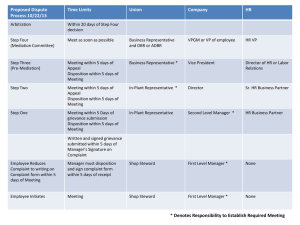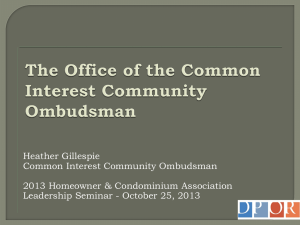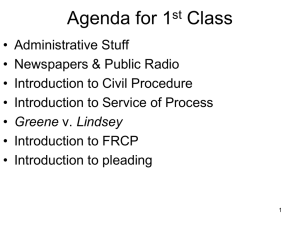Board of Assessment Review - Dutchess County Government
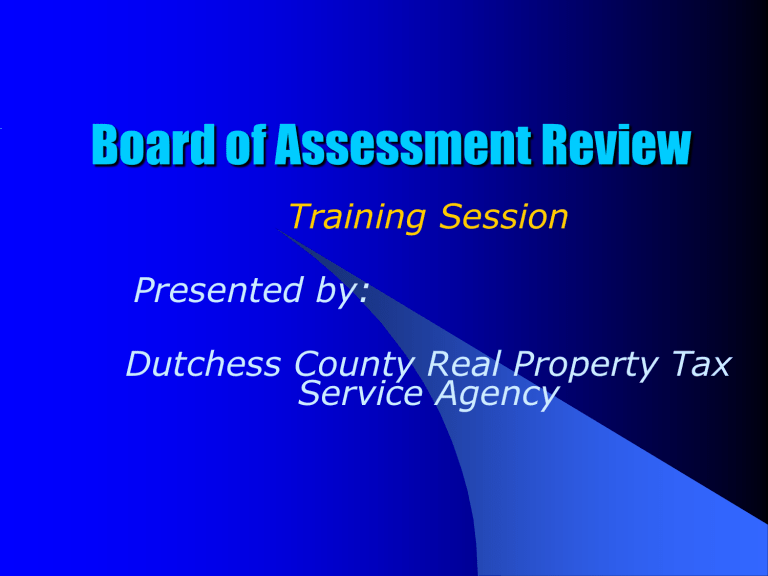
Board of Assessment Review
Training Session
Presented by:
Dutchess County Real Property Tax
Service Agency
Dutchess County Real Property Tax Service
Agency
22 Market Street
Poughkeepsie, NY 12601
Eric Axelsen, Director
Phone (845) 486-2140
eaxelsen@co.dutchess.ny.us
Website
www.dutchessny.gov
Authority on Training and Certification
NYS Dept. of Taxation & Finance
Office of Real Property Services (ORPTS)
WA Harriman State Campus
Albany, NY 12227
Colleen Sheehan, Educational Services
Phone (518) 474-1764
colleen.sheehan@orps.state.ny.us
ORPS
website www.orps.state.ny.us
Unit 1
Introduction and Equity in
Assessment Administration
Lesson 1 – Reasons for Training and Course Overview
Reasons for Training
Real Property Tax Law requires initial appointees and reappointees must attend training session given by
County Director
Course Overview
5.
6.
3.
4.
1.
2.
7.
8.
9.
10.
Equity in assessment administration
Board of Assessment Review profile
Grievance Day preparation
Powers and duties of the BAR
Assessment of Real Property
Holding grievance hearings
Grounds for complaint
Determinations of BAR
Second Meeting(s) of BAR and subsequent complaint routes
Video
The Real Property Tax
Ad Valorem Tax – based on ‘value’
Value is defined as ‘market Value’
Tax is determined by municipal budgets
Equitable assessments fairly distribute the property tax
Property owners can only grieve their assessments, not their tax amount
New York statutes set forth the procedure to be followed by property owners who have a complaint about their assessment
Filing a petition with the Board of Assessment Review is a required (very important) first step
Small Claims Assessment Review (hearing officer)
Tax Certiorari (Court Proceeding)
Lesson 2 - Role of the Assessor
Primary responsibilities of the assessor
Discover, list, and place a value on all real property
Establish market value as of July 1 of prior year (valuation date)
Assess according to ‘condition and ownership’ as of
March 1 (taxable status date)
Determine exemption eligibility
Role of the Assessor in relation to the Board of
Assessment Review
Assessor files a tentative assessment roll by May 1
Assessor publishes notice of filing which includes dates and times that the Board of Review will meet
Must attend all hearings
Can request an adjournment
Lesson 3 – Role of the Board of Assessment Review
1.
2.
Quasi-judicial body – charged with the judicial responsibility to get the facts, apply the law
Each member should a) possess judicial temperament b) provide a fair hearing c) safeguard constitutional guarantees of due process of law d) abstain if personally involved
Unit 2 - Board of Assessment
Review Profile
Lesson 1 - Profile
Composition – BAR consists of not less than three nor more than five members
Majority can not be officers or employees of local government
5 year term – staggered
Oct 1 – Sept 30
Temporary members can be appointed for 1 year to create hearing panels
Qualifications
Knowledge of property values
18 yrs old
U.S. Citizen
Resident of the Town
Must file an oath of office
Hearing Panels
RPTL 523-a allows temporary members to be appointed in any year (usually in re-val year)
1 year terms
Maximum of 2 temporary members for each regular member
Must meet same qualifications, same training
Same powers as BAR, EXCEPT will NOT determine final value
Temps make recommendations to BAR
Temps can not fill in for absent permanent BAR members
Lack of quorum
Must have two of a three member board present or three of a four or five member board present
If not –
County treasurer
Chairman of the legislature
Clerk of the legislature shall serve as acting Board of Assessment Review
New hearing date scheduled around 3 rd week in June (RPTL 527)
Lesson 2 – Training and Certification
RPTL 523 (d)
Mandates initial appointees and re-appointees attend this training
Extensions can only be granted by request of NYS ORPS
Educational Services
Unit 3 - Grievance Day
Preparation
Lesson 1 – Grievance day preparation by the BAR
Grievance day is 4th Tuesday in May
If assessor in more than one town a Local Law can be adopted to change that date, but no later than 2 nd Tuesday in June OR assessor can appoint one or more members of staff to fill in
Board members must have training certification
Must select a chairperson
Chairperson’s role is to facilitate the meeting, keep order, administer oaths
Informational Meeting with assessor
Get generally acquainted with tentative assessment roll
Assessor’s techniques and methods for valuation
Fact sheet – LOA, RAR, Equalization Rate, Trends
Most important in reassessment and sustaining equity municipalities
Local “Fact Sheet”
Veteran’s Exemption Ceiling values.
Senior’s income limits for County, Town, Village, and all Schools in your town.
Homestead for Town or School(s)?
Other Local Options.
Unit 4
Powers and Duties of the Board of
Assessment Review
Lesson 1
3.
4.
1.
2.
5.
6.
Administer oaths
Take Testimony
Hear proofs
Require personal appearances
Require more information
Determine the final assessment/exemption status
Evidence should accompany the complaint filed
Complainant can offer additional documentation at the hearing
All oral and written testimony is taken under oath
Each person testifying is sworn in individually
Hearing testimony and taking proof
Personal appearances not necessary
Board may require a personal appearance
Complainant not entitled to any reduction if willful neglect or refusal to supply requested information (dismissal) (RPTL 525 (2))
Minutes
Minutes of the proceedings must be taken and filed with the town clerk
Disclosure of interest (RP523-dcl)
BAR Member must file if he has any interest in a property coming before the board and should abstain from the discussion (recusal).
Agreements between municipalities can allow board member’s grievance to be heard in the other municipality (RPTL 523 (3))
Unit 5
Assessment of Real Property
Lesson 1 – Assessment of Real Property
Standard of Assessment
RPTL 300 – All real property is subject to taxation unless specifically exempted by statute
RPTL 302 – Real property must be assessed according to its condition and ownership as of taxable status date
(March 1)
RPTL 305 – The standard of assessment in NYS is that all real property in each assessing unit be assessed at a uniform percentage of value
What is value?
Value has been defined by the courts to mean ‘Market
Value’
Assessor must assess property at its ‘value in current use’ not highest and best or future potential use
(farms, residence in commercial zone, etc.)
Exception is vacant land parcels not being put to any particular use can be assessed at highest and best use
Level of Assessment
Level of Assessment (a/k/a Uniform Percent of Value) tells us what percent of market value is being used that year to determine assessments. It is stated by the assessor – must appear on roll and bill.
For example–
If level of assessment is stated as 75%, a property with an estimated market value of $300,000 should be assessed at approximately
$225,000
$225,000 / .75 = $300,000
$300,000 x .75 = $225,000
If level of assessment is stated as 33%, a property with an estimated market value of $300,000 should be assessed at approximately
$99,000
$99,000 / .33 = $300,000
$300,000 x .33 = $99,000
Reassessments are usually at 100% of market value – the assessment and the market value would be the same.
Sustaining Equity –
Annual reassessments maintain that level of 100% assessments are reviewed annually and changes are made accordingly
Important to remember that ad valorem is a tax based on value – not ability to pay or any other personal issue
3 approaches to value
Market Value approach – for property types readily bought and sold
Income approach – used for rental properties
Cost approach – specialty property, utilities
Assessor is responsible for collecting the data and applying the most appropriate method
Annual re-assessment
Systematic review of all locally assessed property in the municipality
Systematic analysis is a methodical, thorough and regular review and examination of assessments
CAMA – Computer Assisted Mass Appraisal
Assessments to Sale Price ratios are used to determine trends
Different areas or neighborhoods can have different trends
These trends are applied to assessments to maintain those assessments at 100% of value
Unit 6
Grievance Hearings
Lesson 1 – Holding Grievance Hearings
Grievance hearings must be in compliance with the open meetings law (accessible, open to public)
BAR must meet to make final determinations (executive session, closed)
Lesson 2 – Fair hearings
Keeping an open mind
All persons involved have a full opportunity to make statements, present testimony and produce evidence
Basic objective is to review the facts presented to you so that a fair decision can be made
Complaint requirements
Adjourned hearing dates
1.
Assessor requests
2.
3.
Further documentation required
Too many to hear
(No new complaints can be filed at an adjourned hearing)
Unit 7
Grounds for Complaint
Lesson 1- Complaint form – RP524
Must be completely filled out so that parcel can be identified and to give the board a clear understanding of what is being requested
Examples – exemption not properly granted assessed value too high misclassification in homestead status
Lesson 2 – grounds for complaint
Unequal – assessed at a higher percentage of value than other property on the assessment roll
Excessive – assessed greater than market value; denial of partial exemption
Unlawful – Property outside of assessing unit; property can not be identified; assessed by person without authority; special franchise exceeds value set by State
Board
Misclassification – Only applies to jurisdictions that have adopted the homestead provisions of Article 19 RPTL
Unit 8
Determinations of the Board of
Assessment Review
Lesson 1 - Determinations
Making determinations
After hearing all testimony, decisions must be made
Must meet in private – not an open meeting-no minutes taken;
NOT allowed to be present
Can lower assessment or leave unchanged
Burden of Proof
Presumption under the law is that the assessor is correct
Burden of proof is on the property owner who
Must present clear and convincing evidence comparables, sales listings, appraisal - for your review
Assessor’s role in determinations
Give testimony in defense of an assessment
Recommend a reduction in assessment
Stipulate an assessed value
BAR is expected to ratify stipulations
Weighing the evidence
BAR should not re-appraise the property complaint with evidence beyond that of the assessor
Final determination
After the board has met and made its determinations all changes must be listed, verified and delivered to the assessor so that the tentative roll can be changed
The vote of each member must be recorded
Complainant must be notified of the decision, the reason for the decision and how each member voted
Unit 9
Second Meeting
Why a second (and third) meeting?
To review assessment changes pursuant to ‘corrections of errors’ RPTL 553
Assessor submits petitions to the board
Board must meet to approve petitions
When?
One meeting set between July 15 and August 10 (after final roll but before school bills are processed)
Another between October 1 and November 1 (after school bills but before county/town bills are processed)
Lesson 2 - Subsequent complaint routes
Two judicial remedies
Small Claims Assessment Review
1,2,3 family residence, owner occupied certain vacant land only
Tax Certiorari – court proceeding
All property eligible
These remedies are subsequent to the administrative review – not instead of
Unit 10
Summary and Review
Basic premise for your determination
Assessment challenged/not taxes
Has the property owner supplied sufficient and convincing evidence to prove the assessment is incorrect?
Yes? Make appropriate reduction
No? Assessment remains unchanged
Check out integrated tax maps, aerial photos and current assessment information on
ParcelAccess at www.dutchessny.gov
This presentation is on the web – www.dutchessny.gov
go to
RPT page
Visit www.orps.state.ny.us
for more information on Real Property
Tax and Assessment information
Any Questions?
Newly appointed must stay for video
Re-appointed – video optional
Don’t forget your copy of certification
Don’t forget to file your Oath of Office


